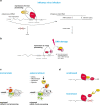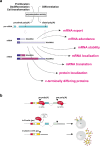Processing and transcriptome expansion at the mRNA 3' end in health and disease: finding the right end
- PMID: 27220521
- PMCID: PMC4893057
- DOI: 10.1007/s00424-016-1828-3
Processing and transcriptome expansion at the mRNA 3' end in health and disease: finding the right end
Abstract
The human transcriptome is highly dynamic, with each cell type, tissue, and organ system expressing an ensemble of transcript isoforms that give rise to considerable diversity. Apart from alternative splicing affecting the "body" of the transcripts, extensive transcriptome diversification occurs at the 3' end. Transcripts differing at the 3' end can have profound physiological effects by encoding proteins with distinct functions or regulatory properties or by affecting the mRNA fate via the inclusion or exclusion of regulatory elements (such as miRNA or protein binding sites). Importantly, the dynamic regulation at the 3' end is associated with various (patho)physiological processes, including the immune regulation but also tumorigenesis. Here, we recapitulate the mechanisms of constitutive mRNA 3' end processing and review the current understanding of the dynamically regulated diversity at the transcriptome 3' end. We illustrate the medical importance by presenting examples that are associated with perturbations of this process and indicate resulting implications for molecular diagnostics as well as potentially arising novel therapeutic strategies.
Keywords: Alternative cleavage and polyadenylation (APA); Cancer; Disease; Post-transcriptional gene regulation; RNA 3′ end maturation; Transcriptome diversity.
Figures





Similar articles
-
TREND-DB-a transcriptome-wide atlas of the dynamic landscape of alternative polyadenylation.Nucleic Acids Res. 2021 Jan 8;49(D1):D243-D253. doi: 10.1093/nar/gkaa722. Nucleic Acids Res. 2021. PMID: 32976578 Free PMC article.
-
TRENDseq-A highly multiplexed high throughput RNA 3' end sequencing for mapping alternative polyadenylation.Methods Enzymol. 2021;655:37-72. doi: 10.1016/bs.mie.2021.03.022. Epub 2021 May 26. Methods Enzymol. 2021. PMID: 34183130
-
Implications of polyadenylation in health and disease.Nucleus. 2014;5(6):508-19. doi: 10.4161/nucl.36360. Epub 2014 Oct 31. Nucleus. 2014. PMID: 25484187 Free PMC article. Review.
-
Alternative Polyadenylation Is a Novel Strategy for the Regulation of Gene Expression in Response to Stresses in Plants.Int J Mol Sci. 2023 Mar 1;24(5):4727. doi: 10.3390/ijms24054727. Int J Mol Sci. 2023. PMID: 36902157 Free PMC article. Review.
-
Alternative cleavage and polyadenylation in spermatogenesis connects chromatin regulation with post-transcriptional control.BMC Biol. 2016 Jan 22;14:6. doi: 10.1186/s12915-016-0229-6. BMC Biol. 2016. PMID: 26801249 Free PMC article.
Cited by
-
TREND-DB-a transcriptome-wide atlas of the dynamic landscape of alternative polyadenylation.Nucleic Acids Res. 2021 Jan 8;49(D1):D243-D253. doi: 10.1093/nar/gkaa722. Nucleic Acids Res. 2021. PMID: 32976578 Free PMC article.
-
mRNA Metabolism in Cardiac Development and Disease: Life After Transcription.Physiol Rev. 2020 Apr 1;100(2):673-694. doi: 10.1152/physrev.00007.2019. Epub 2019 Nov 21. Physiol Rev. 2020. PMID: 31751167 Free PMC article. Review.
-
Signaling Pathways Driving Aberrant Splicing in Cancer Cells.Genes (Basel). 2017 Dec 29;9(1):9. doi: 10.3390/genes9010009. Genes (Basel). 2017. PMID: 29286307 Free PMC article. Review.
-
Dynamic Variations of 3'UTR Length Reprogram the mRNA Regulatory Landscape.Biomedicines. 2021 Oct 28;9(11):1560. doi: 10.3390/biomedicines9111560. Biomedicines. 2021. PMID: 34829789 Free PMC article. Review.
-
Unveiling ncRNA regulatory axes in atherosclerosis progression.Clin Transl Med. 2020 Feb 3;9(1):5. doi: 10.1186/s40169-020-0256-3. Clin Transl Med. 2020. PMID: 32009226 Free PMC article. Review.
References
Publication types
MeSH terms
Substances
LinkOut - more resources
Full Text Sources
Other Literature Sources

